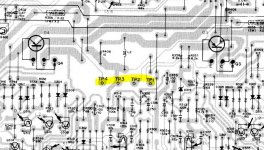Hi guys.
I am trying to repair this old amplifier but I'm running out of idea's. I have checked almost everything on the board it's such a simple amplifier but just can't find what's causing the output fets to blow on switch on. I have rail voltages present.. I pulled out every transistor and tested with my multimeter... Checked all the diodes, caps resistors... Now I have run out of things to check... Does anyone have any idea what check or should I just scrap this amplifier. Thanks in advance
I am trying to repair this old amplifier but I'm running out of idea's. I have checked almost everything on the board it's such a simple amplifier but just can't find what's causing the output fets to blow on switch on. I have rail voltages present.. I pulled out every transistor and tested with my multimeter... Checked all the diodes, caps resistors... Now I have run out of things to check... Does anyone have any idea what check or should I just scrap this amplifier. Thanks in advance
You certainly mean you blow the output stage. The reason for that is often an incorrect BIAS assuming your amplifier is Class AB. A wrong bias means too much current passes through the output stage, effectively shorting the output between the power rails. Another reason which you did not test, is whether the amplifier is not oscillating. Audio amplifiers like to oscillate at several hundred kilohertz: this is extremely damaging for output stages.
To save parts I suggest you use the good old method of a filament bulb connected in series with the mains. In the event of a fault the bulb takes the mains voltage saving your amplifier of blown parts. Needless to state the bulb must be rated to be used on the mains. 100W should be enough, even 60W.
To save parts I suggest you use the good old method of a filament bulb connected in series with the mains. In the event of a fault the bulb takes the mains voltage saving your amplifier of blown parts. Needless to state the bulb must be rated to be used on the mains. 100W should be enough, even 60W.
Suggest build a "dim bulb tester", a current limiting device, an incandescent bulb in series with the active mains, numerous plans on the net. Output transistors often need a few "amps/volts" before they fail, more than what your MM can provide. If an item tests OK it still can be faulty. The DBT with a 30W bulb might allow you to power up and check b/c/e voltages to GND at the outputs Q1,2,3,4
How can I check for incorrect bias current.
There are two variable resistors for idle current adjustment.
How do I check for oscillation.
With the output transistors removed the amplifier will power up as normal allowing me to check voltages. I have voltage on ECB on all four output transistor pins.
There are two variable resistors for idle current adjustment.
How do I check for oscillation.
With the output transistors removed the amplifier will power up as normal allowing me to check voltages. I have voltage on ECB on all four output transistor pins.
Refer to the service manual (freely available on hifiengine) for bias procedure.
Maybe post the e/c/b voltages at the outputs
Maybe post the e/c/b voltages at the outputs
i had a look at the service manual - if we are talking about the same amplifier there are BJT output devices, no FETs. The Vbe-multiplier in the manual is a little tricky, buildt of two complementary CFP circuits, the maximum output of the multiplier is defined by a Z-Diode.
When i look at the questions you are asking i guess your knowledge in electronics is the one of a beginner? right? ...so high power electronics is not an easy (cheap) way to learn.
the bias current is measured across the Emitter Resistors of the output stage, the value you should read is 26mV (20-30mV is ok). when you read more and / or no adjustment is possible, change the potentiometer. If it is defect in this configuration of the Vbe multiplier, the bias current is "running away"...
to check for oscillation take an oscilloscope and connect it to the amps output...
When i look at the questions you are asking i guess your knowledge in electronics is the one of a beginner? right? ...so high power electronics is not an easy (cheap) way to learn.
the bias current is measured across the Emitter Resistors of the output stage, the value you should read is 26mV (20-30mV is ok). when you read more and / or no adjustment is possible, change the potentiometer. If it is defect in this configuration of the Vbe multiplier, the bias current is "running away"...
to check for oscillation take an oscilloscope and connect it to the amps output...
Thanks for the reply guys... I have decided to scrap the amplifier... Yes I am a beginner... And when it comes to bias current and other detailed stuff I'm not capable of doing.
"All" vintage amps require bias current and other technical stuff. Probably means you should find another hobby or learn some of the basic stuff. Practice on something disposable like a SA-940. Checking the bias is a straight forward voltage measurement, refer to the service manual, if in doubt ask questions.
- Home
- Amplifiers
- Solid State
- Pioneer sa940
